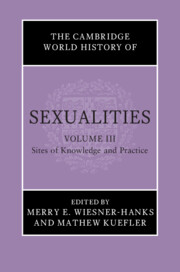Book contents
- The Cambridge World History of Sexualities
- The Cambridge World History of Sexualities
- The Cambridge World History of Sexualities
- Copyright page
- Contents
- Figures in Volume III
- Tables in Volume III
- Contributors to Volume III
- Editors’ Preface to the Series
- 1 Sex in Athens in the Fifth and Fourth Centuries bce
- 2 Sex in Rome in the First Century bce and the First Century ce
- 3 Sex in Constantinople in the Sixth Century ce
- 4 Sex in Chang’an in the Eighth and Ninth Centuries ce
- 5 Sexuality in Baghdad in the Ninth and Tenth Centuries ce
- 6 Sex in Heian-kyō (Kyoto) in the Tenth through Twelfth Centuries ce
- 7 Sex in Iceland in the Fourteenth and Fifteenth Centuries ce
- 8 Sex in Florence in the Fifteenth Century
- 9 Sexuality in Tenochtitlan in the Early Sixteenth Century
- 10 Sex in Sixteenth-Century Istanbul
- 11 Sex in Geneva in the Sixteenth Century
- 12 Sex in Eighteenth-Century Edo (Tokyo)
- 13 Sex in Eighteenth-Century Paris
- 14 Sex and Sexuality in Eighteenth-Century Philadelphia
- 15 Sex in Nineteenth-Century Cairo
- 16 Sexual Pleasures and Perils in Nineteenth-Century London
- 17 Sex in Manila in the Late Nineteenth and Early Twentieth Centuries
- 18 Sex in Lagos from the Mid-Nineteenth to the Mid-Twentieth Century
- 19 Sex in Bombay in the Late Nineteenth and Early Twentieth Centuries
- 20 Sexuality in a Distant Metropolis: Buenos Aires from the Late Nineteenth to the Mid-Twentieth Century
- 21 Sex in Early Twentieth-Century Berlin
- 22 Sex in Sydney in the Twentieth Century
- 23 Toronto the Good, Toronto the Gay: Sex and Morality in the Twentieth Century
- 24 Sex in Shanghai in the Twentieth Century: Intimate Negotiations
- 25 Sex in Twentieth-Century Rio de Janeiro
- Index
- CONTENTS TO VOLUMES I, II, AND IV
- References
17 - Sex in Manila in the Late Nineteenth and Early Twentieth Centuries
Published online by Cambridge University Press: 26 April 2024
- The Cambridge World History of Sexualities
- The Cambridge World History of Sexualities
- The Cambridge World History of Sexualities
- Copyright page
- Contents
- Figures in Volume III
- Tables in Volume III
- Contributors to Volume III
- Editors’ Preface to the Series
- 1 Sex in Athens in the Fifth and Fourth Centuries bce
- 2 Sex in Rome in the First Century bce and the First Century ce
- 3 Sex in Constantinople in the Sixth Century ce
- 4 Sex in Chang’an in the Eighth and Ninth Centuries ce
- 5 Sexuality in Baghdad in the Ninth and Tenth Centuries ce
- 6 Sex in Heian-kyō (Kyoto) in the Tenth through Twelfth Centuries ce
- 7 Sex in Iceland in the Fourteenth and Fifteenth Centuries ce
- 8 Sex in Florence in the Fifteenth Century
- 9 Sexuality in Tenochtitlan in the Early Sixteenth Century
- 10 Sex in Sixteenth-Century Istanbul
- 11 Sex in Geneva in the Sixteenth Century
- 12 Sex in Eighteenth-Century Edo (Tokyo)
- 13 Sex in Eighteenth-Century Paris
- 14 Sex and Sexuality in Eighteenth-Century Philadelphia
- 15 Sex in Nineteenth-Century Cairo
- 16 Sexual Pleasures and Perils in Nineteenth-Century London
- 17 Sex in Manila in the Late Nineteenth and Early Twentieth Centuries
- 18 Sex in Lagos from the Mid-Nineteenth to the Mid-Twentieth Century
- 19 Sex in Bombay in the Late Nineteenth and Early Twentieth Centuries
- 20 Sexuality in a Distant Metropolis: Buenos Aires from the Late Nineteenth to the Mid-Twentieth Century
- 21 Sex in Early Twentieth-Century Berlin
- 22 Sex in Sydney in the Twentieth Century
- 23 Toronto the Good, Toronto the Gay: Sex and Morality in the Twentieth Century
- 24 Sex in Shanghai in the Twentieth Century: Intimate Negotiations
- 25 Sex in Twentieth-Century Rio de Janeiro
- Index
- CONTENTS TO VOLUMES I, II, AND IV
- References
Summary
The late nineteenth century and early twentieth century saw seismic political and social change in the Philippines. It was a period marked by a series of watershed events: Spain’s ignominious defeat and the loss of the colony in 1899 to the United States; a subsequent bloody war and brutal pacification campaign waged by the US resulting in Philippine defeat and American colonization, the effects of which would reshape local societies and endure well beyond the next half a century. Tracking across a wealth of disparate sources, including colonial missionary confessional manuals and etiquette handbooks, photographs, and popular culture, this chapter explores Manila’s dance halls, brothels, and opium dens, popular folksongs and ballads that celebrated female sexual allure or lamented the mundanity of married life. Who were considered the arbiters and experts of sexual behaviour and what forms were deemed the most dangerous to morality, health, and public order? In the process of examining prevailing anxieties over sexuality, the chapter foregrounds a plethora of erotic intimacies, sexual habits and appetites, pleasures, and practices, and how these were expressed and experienced in a city that bore the brunt of revolutionary upheavals.
Keywords
- Type
- Chapter
- Information
- The Cambridge World History of Sexualities , pp. 353 - 378Publisher: Cambridge University PressPrint publication year: 2024



